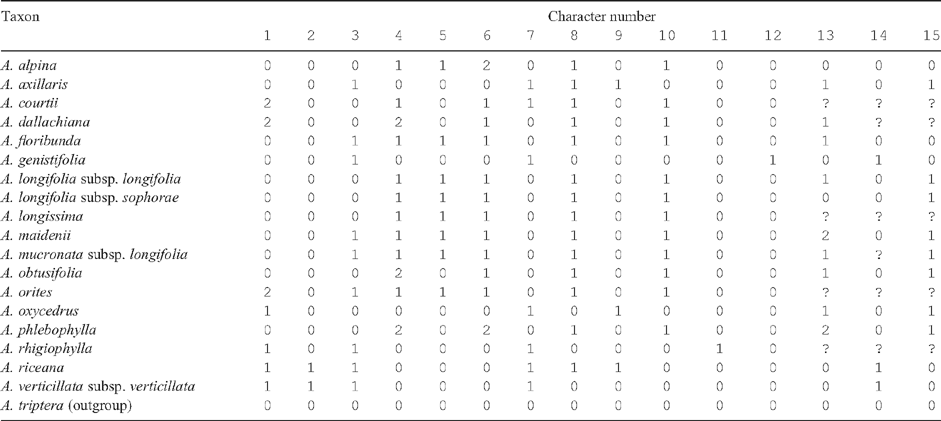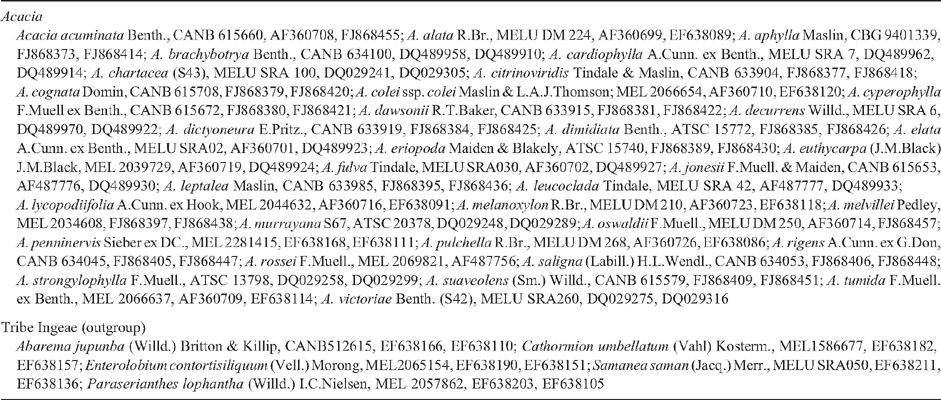Phylogenetic analysis based on nuclear DNA and morphology defines a clade of eastern Australian species of Acacia s.s. (section Juliflorae): the ‘Acacia longifolia group’
Gillian K. Brown A B C , Catherine Clowes A , Daniel J. Murphy B and Pauline Y. Ladiges AA School of Botany, The University of Melbourne, Vic. 3010, Australia.
B National Herbarium of Victoria, Royal Botanic Gardens Melbourne, Vic. 3141, Australia.
C Corresponding author. Email: browngk@unimelb.edu.au
Australian Systematic Botany 23(3) 162-172 https://doi.org/10.1071/SB09037
Submitted: 14 August 2009 Accepted: 19 April 2010 Published: 14 July 2010
Abstract
Seventeen Australian, phyllodinous species of Acacia s.s. (from sections Juliflorae and Phyllodineae) were analysed to test the monophyly and relationships of ‘the Acacia longifolia group’, an informal group recognised in the Flora of Australia. Analyses were based on both morphological and molecular data, with A. triptera as an outgroup. A total of 92 herbarium specimens was investigated, with 15 phyllode, inflorescence, flower, pod and seed characters scored. The ITS and ETS regions of nuclear rDNA were sequenced and combined with a larger dataset sampled from species of all major clades of Acacia, totalling 65 accessions. Cladistic analyses provided evidence of a clade that defines the A. longifolia group as follows: A. alpina, A. axillaris, A. courtii, A. dallachiana, A. derwentiana, A. floribunda, A. longifolia subsp. longifolia and A. longifolia subsp. sophorae, A. longissima, A. maidenii, A. mucronata, A. obtusifolia, A. orites, A. oxycedrus, A. phlebophylla, A. rhigiophylla and A. riceana (all sect. Juliflorae), but excluding A. verticillata (section Juliflorae) and A. genistifolia (section Phyllodineae). The A. longifolia group is recognised as including south-eastern Australian species with cylindrically spiked inflorescences and phyllodes with prominent anastomosing venation.
Acknowledgements
The authors thank Mark Bachmann for his interest in this project and assistance in the field. The National Herbarium of Victoria (MEL) and The University of Melbourne Herbarium (MELU) are thanked for access to material for this study. Funding was provided by Australian Research Council Linkage Grant number LP0669625. Dr Michael Bayly and Dr Alison Kellow are thanked for providing DNA samples of Acacia dallachiana and A. phlebophylla.
Andrew RL,
Miller JT,
Peakall R,
Crisp MD, Bayer RJ
(2003) Genetic, cytogenetic and morphological patterns in a mixed mulga population: evidence for apomixis. Australian Systematic Botany 16, 69–80.
| Crossref | GoogleScholarGoogle Scholar |
CAS |

Ariati SR,
Murphy DJ,
Udovicic F, Ladiges PY
(2006) Molecular phylogeny of three groups of acacias (Acacia subgenus Phyllodineae) in arid Australia based on the internal and external spacer regions of nrDNA. Systematics and Biodiversity 4, 417–426.
| Crossref | GoogleScholarGoogle Scholar |

Baldwin BG, Markos S
(1998) Phylogenetic utility of the external transcribed spacer (ETS) of 18S–26S rDNA: congruence of ETS and ITS trees of Calycadenia (Compositae). Molecular Phylogenetics and Evolution 10, 449–463.
| Crossref | GoogleScholarGoogle Scholar |
CAS |
PubMed |

Brain P, Maslin BR
(1996) A serological investigation of the classification of Acacia subgenus Phyllodineae (Legumionsae: Mimosoideae). Biochemical Systematics and Ecology 24, 379–392.
| Crossref | GoogleScholarGoogle Scholar |
CAS |

Brown GK,
Ariati SR,
Murphy DJ,
Miller JT, Ladiges PY
(2006) Bipinnate acacias of eastern Australia are polyphyletic based on DNA sequence data. Australian Systematic Botany 19, 315–326.
| Crossref | GoogleScholarGoogle Scholar |
CAS |

Brown GK,
Murphy DJ,
Miller JT, Ladiges PY
(2008) Acacia s.s. and its relationship among tropical legumes, tribe Ingeae (Leguminosae: Mimosoideae). Systematic Botany 33, 739–751.
| Crossref | GoogleScholarGoogle Scholar |

Bukhari YM,
Koivu K, Tigerstedt PMA
(1999) Phylogenetic analysis of Acacia (Mimosaceae) as revealed from chloroplast RFLP data. Theoretical and Applied Genetics 98, 291–298.
| Crossref | GoogleScholarGoogle Scholar |

Carr GW
(2001) Australian plants as weeds in Victoria. Plant Protection Quarterly 16, 124–125.

Conn BJ, Tame TM
(1996) A revision of the Acacia uncinata group (Fabaceae–Mimosoideae). Australian Systematic Botany 9, 827–857.
| Crossref | GoogleScholarGoogle Scholar |

Emeny J,
Duff G,
Simmons D, Wallis A
(2006) Investigating the distribution of Acacia longifolia ssp. sophorae in south-west Victoria using satellite remote sensing and GIS. Plant Protection Quarterly 21, 30–38.

Gardner SK,
Murphy DJ,
Newbigin E,
Drinnan AN, Ladiges PY
(2005) An investigation of phyllode variation in Acacia verniciflua and A. leprosa (Mimosaceae), and implications for taxonomy. Australian Systematic Botany 18, 383–398.
| Crossref | GoogleScholarGoogle Scholar |

Gray AM
(2005) Acacia derwentiana (Mimosaceae), a new species from southern Tasmania. Muelleria 21, 107–110.

Hall TA
(1999) BioEdit: a user-friendly biological sequence alignment editor and analysis program for Windows 95/98/NT. Nucleic Acids Symposium Series 41, 95–98.
|
CAS |

Käss E, Wink M
(1997) Molecular phylogeny and phytogeography of Lupinus (Leguminosae) inferred from nucleotide sequences of the rbcL gene and ITS 1+2 regions of rDNA. Plant Systematics and Evolution 208, 139–167.
| Crossref | GoogleScholarGoogle Scholar |

Marchante E,
Kjøller A,
Struwe S, Freitas H
(2008) Short- and long-term impacts of Acacia longifolia invasion on the below ground processes of a Mediterranean coastal dune ecosystem. Applied Soil Ecology 40, 210–217.
| Crossref | GoogleScholarGoogle Scholar |

Maslin BR, Stirton CH
(1997) Generic and infrageneric classification in Acacia (Leguminosae: Mimosoideae): a list of critical species on which to build a comparative data set. Bulletin of the International Group for the Study of Mimosoideae 20, 22–24.

McDonald MW, Maslin BR
(2000) Taxonomic revision of the salwoods: Acacia aulacocarpa Cunn. ex Benth. and its allies (Leguminosae: Mimosoideae: section Juliflorae). Australian Systematic Botany 13, 21–78.
| Crossref | GoogleScholarGoogle Scholar |

Miller JT,
Andrew R, Bayer RJ
(2003a) Molecular phylogenetics of the Australian acacias of subg. Phyllodineae (Fabaceae: Mimosoideae) based on the trnK intron. Australian Journal of Botany 51, 167–177.
| Crossref | GoogleScholarGoogle Scholar |
CAS |

Miller JT,
Grimes JW,
Murphy DJ,
Bayer RJ, Ladiges PY
(2003b) A phylogenetic analysis of the Acacieae and Ingeae (Mimosoideae: Fabaceae) based on trnK, matK, psbA–trnH, and trnL/trnF sequence data. Systematic Botany 28, 558–566.

Murphy DJ,
Udovicic F, Ladiges PY
(2000) Phylogenetic analysis of Australian Acacia (Leguminosae: Mimosoideae) by using sequence variations of an intron and two intergenic spacers of chloroplast DNA. Australian Systematic Botany 13, 745–754.
| Crossref | GoogleScholarGoogle Scholar |

Murphy DJ,
Miller JT,
Bayer RJ, Ladiges PY
(2003) Molecular phylogeny of Acacia subgenus Phyllodineae (Mimosoideae: Leguminosae) based on DNA sequences of internal transcribed spacer region. Australian Systematic Botany 16, 19–26.
| Crossref | GoogleScholarGoogle Scholar |
CAS |

Murphy DJ,
Brown GK,
Miller JT, Ladiges PY
(2010) Molecular phylogeny of Acacia s.s. (Mimosoideae: Leguminosae) – evidence for major clades and informal classification. Taxon 59, 7–19.

Murray DR,
Ashcroft WJ,
Seppelt RD, Lennox FG
(1978) Comparative biochemical and morphological studies of Acacia sophorae (Labill.) R.Br and A. longifolia (Andrews) Willd. Australian Journal of Botany 26, 755–771.
| Crossref | GoogleScholarGoogle Scholar |
CAS |

Pedley L
(1978) A revision of Acacia Mill. in Queensland. Austrobaileya 1, 164.

Ronquist F, Huelsenbeck JP
(2003) MrBayes 3: Bayesian phylogenetic inference under mixed models. Bioinformatics (Oxford, England) 19, 1572–1574.
| Crossref | GoogleScholarGoogle Scholar |
CAS |
PubMed |

Sun Y,
Skinner DZ,
Liang GH, Hulbert SH
(1994) Phylogenetic analysis of Sorghum and related taxa using internal transcribed spacers of nuclear ribosomal DNA. Theoretical and Applied Genetics 89, 26–32.
| Crossref | GoogleScholarGoogle Scholar |
CAS |


|



